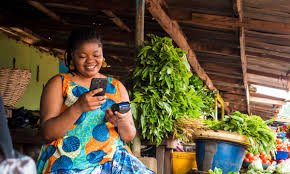by Xinhua writers Xu Jiatong, Yang Jun
NAIROBI/BEIJING, Oct. 8 (Xinhua) — On the bustling streets of Nairobi, the green glow of the M-Pesa (a mobile money platform) logo is inescapable, from high-end hotels to street vendors. In some tourist hotspots, signs declaring “No Cash” highlight a striking shift: over 90 percent of adults in the East African country now use mobile payments.
Across Africa, digital payments are booming, with 17 percent of consumers using them daily and nearly half at least weekly in 2023. The rise of mobile money has reshaped business and daily lives alike, where smartphones are the new wallets.
What has contributed to the rapid development and widespread adoption of mobile payments in Africa?
ACCESSIBLE & COST-EFFECTIVE
The number of digital payment users in Sub-Saharan Africa increased by 191 million between 2014 and 2021, according to the World Bank. In 2022, McKinsey estimated Africa’s digital payments market would grow by 152 percent from 2020 to 2025.
What are some of the favorable conditions that led to the rapid adoption of digital payment in Africa? Firstly, the number of smartphone users is rapidly increasing among a young and urbanizing population, creating a solid foundation for digital payments.
Secondly, digital payments are more convenient and efficient compared to traditional financial services which are often too expensive and not accessible in some areas. Moreover, the rapid expansion of mobile Internet coverage supports the widespread adoption of digital payments across the continent.
For many Africans, owning a phone is easier than having a bank account. Thus, mobile payment, with its very low access threshold, has become the preferred payment method.
This payment method is fast, convenient, and cost-effective, especially for cross-border transfers.
It is estimated that the average fee for a 200-U.S.-dollar mobile payment transfer is only 2.77 percent, significantly lower than the 6.09 percent for traditional payment methods. According to data obtained by dLocal, an international payment platform, the number of registered mobile payment accounts worldwide exceeded 1.75 billion by the end of 2023, with over 156 companies operating in this sector in sub-Saharan Africa.
MOBILE MONEY
Mobile money is the leading and most dynamic form of digital payment in Africa. Africa remains the region with the largest and fastest growth in the global mobile money sector, according to The State of the Industry Report on Mobile Money 2024 released by GSMA, an international mobile operator association.
In 2023, the number of mobile money accounts in Africa reached 856 million, accounting for 49 percent of registered accounts worldwide, and 136 million new accounts were opened, representing over 70 percent of total global growth.
M-Pesa in Kenya is a representative case. As one of the largest mobile money platforms in Africa, M-Pesa has made Kenya a leader in financial inclusion in sub-Saharan Africa. According to data from the Communications Authority of Kenya, by March 2024, the number of mobile money users in Kenya reached 38.7 million, representing 75 percent of the total population. Among them, M-Pesa held a market share of 94.9 percent.
M-Pesa, which means “mobile money” in Swahili, was officially launched by Kenya’s telecommunications company Safaricom in 2007. Since 2012, Huawei Technologies Co., Ltd. has been a partner of the telecom operator to provide technical solutions, assist in system upgrades, and bring new products and services to Africa.
With a simple mobile phone, without an Internet connection or bank card, users can make transfers, payments, and purchases simply through SMS messages. This convenient payment method is very popular locally and has evolved into an integrated platform offering various financial services such as deposits, transfers, payments, loans, and financial management. It has expanded into seven African countries, becoming a leading service for mobile payment on the continent.
Mobile payment applications like M-Pesa are widespread in Africa. Nigeria, the most populous country in Africa with a population of over 200 million with a median age of 18.1 years, saw nearly 80 percent of real-time payment transactions conducted via mobile phones in 2020, according to local media.
In South Africa, logos of mobile payment platforms like SnapScan and Zapper can be found everywhere in restaurants, hotels, parking lots, and shopping malls.
CHINA-AFRICA COOPERATION
In early October, PalmPay, one of the emerging digital payment platforms in Nigeria, launched a new USSD code function that allows users without smartphones or those facing Internet connectivity issues to access its services.
Chika Nwosu, the managing director of PalmPay, said that more Nigerians are embracing digital payment since the last cashless policy implementation of the Central Bank of Nigeria, according to a local media report in May.
The young Nigerian mobile payment company, funded by Chinese investors, is one of the promising stories of China-Africa’s private sector partnership. The number of active PalmPay users has increased fivefold over the past year, reaching 25 million, and the company plans to expand its cross-border operations from Ghana to Kenya, Uganda, and Tanzania.
Nigerians can manage about 80 percent of their financial lives through the PalmPay app on their phone, said Nwosu, adding that by early next year, new features are expected to push the number towards 100 percent.
The success of PalmPay is partly attributed to its constant service innovation. It has so far developed features to allow users to pay energy bills, recharge phone accounts, purchase products and services, conduct bank transfers, and borrow and receive funds, among others.
Africa has seen more domestically grown digital payment solutions like M-Pesa and PalmPay, which drive the continent’s digital transition and economic development with locally tailored innovations, boosted by South-South cooperation, unleashing the development potential of digital technologies. Enditem

